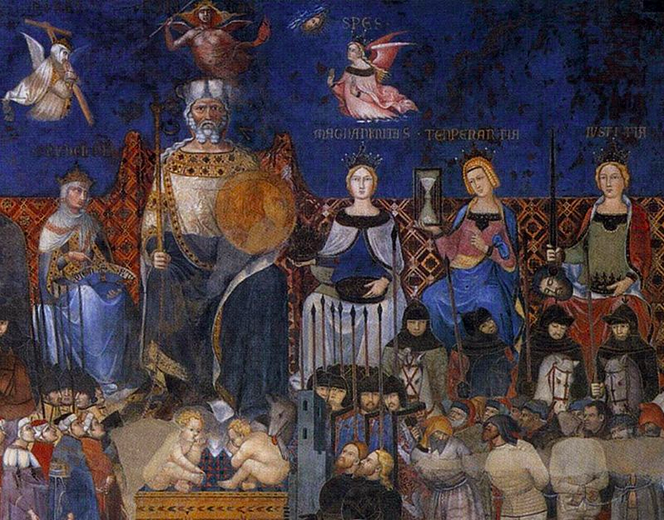
With this post I shall bring my chapter-by-chapter review of Rule of Law by Tom Bingham to a close. In the epilogue to his book, Judge Bingham concludes by describing “The Allegory of Good Government” (pictured in part above), a series of three fresco murals painted by the Italian artist Ambrogio Lorenzetti in the fourteenth century:
In the Hall of the Nine in the Palazzo Pubblico in Siena is Ambrogio Lorenzetti’s depiction of the Allegory of Good Government. Justice, as always, is personified as a woman, gesturing towards the scales of justice, held by the personification of Wisdom. At her feet is Virtue, also a woman. A judge sits in the centre, surrounded by figures including Peace. The Allegory is flanked by two other paintings, illustrating the Effects of Good Government and the Effects of Bad Government. In the first, well-to-do merchants ply their trade, the populace dance in the streets and in the countryside well-tended fields yield a plentiful harvest. The second (badly damaged) is a scene of violence, disease and decay.
With this visual description of this vivid allegory, Judge Bingham then asks the $64 question: “What makes the difference between Good and Bad Government?” Or more to the point, what explains the difference between a stable, peaceful, and prosperous polity and an unstable, crime-ridden, and impoverished one? Or more specifically, what variable best explains the difference between Australia and El Salvador, between Haiti and Japan?
For Bingham, it is the presence of rule of law. Alas, while this conclusion is a plausible one, what if the causation is the other way around? That is, what if it is Good Government (i.e. a government that respects property rights, enforces contracts, and allows markets to flourish) that produces rule of law? Or in the alternative, what if “Good Government” and “Rule of Law” are both caused by a third variable, like “Trust” or “Cold Winters” or “Religion”?
To the point, correlation is not causation, for there are at least three competing and opposing explanations of the relationship between Rule of Law and Good Government. In any case, what Bingham doesn’t mention when he describes Ambrogio Lorenzetti’s masterpiece “The Allegory of Good Government” is that this work was commissioned by the Republic of Siena, a once-prosperous city-state that would begin a long decline a decade after Lorenzetti completed his commission. The ill-fated republic came to an end in 1555.



